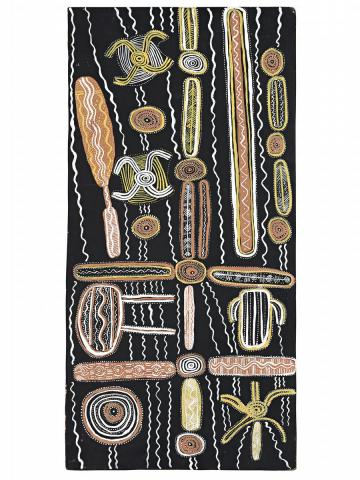WOMEN'S STORY, 1971
MICK NAMARARI TJAPALTJARRI
synthetic polymer powder paint on composition board
81.0 x 41.0 cm
inscribed verso: Stuart Art Centre consignment no. 8018, number 75 and the remnants of an old paper label
Executed at Papunya, 1971
Consignment 8, painting 18,
Stuart Art Centre, Alice Springs
Private Collection
Christie’s Tribal Art, South Kensington,
London, 13 October 1992, Lot 276 (part)
Private collection, Melbourne
For a discussion of the Women’s Dreamings theme see Bardon, G., and Bardon, J., Papunya, A Place Made After the Story: The Beginnings of the Western Desert Painting Movement, The Miegunyah Press, Melbourne, 2004, p. 53, and for another work by the artist executed in 1972 depicting this theme see Bardon and Bardon p. 370 (painting 322)
This work is accompanied by the original Stuart Art Centre certificate.
Described as a reserved man, Mick Namarari Tjapaltajarri was an innovator whose impact on the Western Desert movement is only now starting to be fully appreciated. The breadth and scope of his ability, maintained with singular dedication over a painting career which spanned 27 years, is such that his work is considered to have ‘transformed Papunya Tula art, heralding the ethereal minimalism of the late 1980s and 1990s... Up until he passed away in 1998, Namarari was still quietly revolutionizing the genre...’1
Born in sand hill country at Marnpi Rockhole located southwest of the Mount Rennie Bore, Namarari and his sister were looked after by other family members after the death of both his parents. Namarari attended school at the Hermannsburg mission until he was eleven years old. He was initiated in the Areyonga region and worked as a stockman in the cattle industry. He adopted the middle name ‘Namarari’ after his employer MacNamara, and as it expressed similarities to one of Namarari’s totems, the mallee fowl, it became part of his name.
Namarari was one of the founding members at Papunya Tula Artists and served on the Papunya Council. In 1991 he was awarded the National Aboriginal Art Award, a moment which heralded not only public attention for the Papunya Tula artists, but also confirmed the importance of his practice within the community. In 1994 Namarari was the recipient of the Australia Council’s emeritus award for indigenous artists and joint winner of the Red Ochre Award.
Women’s Story dates from 1971, the first year of the Papunya painting movement when, under the encouragement of Geoffrey Bardon, Namarari and other Pintupi men had begun painting designs on discarded pieces of board at Papunya. Executed on composition board and belonging to what Bardon refers to as Namarari’s more archetypal style, the subject matter is a women’s ceremony. The painting contains ceremonial iconography, a prepared ground, a human figure decorated with body paint, ceremonial boards and weapons, all surrounded by wavy lines indicating fire.
Mick Namarari Tjapaltajarri’s works are loaded with symbolism which is closely tied to narrative, a dense and tightly coded abstraction which elegantly refers to his key stories in ever greater loops. Western Desert painting operates within the space between ceremony and country, referencing each whilst exploring ancestral inheritance. Namarari developed a visual language which was bound by cultural protocol but never restrained by it.
1. Perkins, H., and Fink, H., ‘Genesis and Genius: The Art of Papunya Tula Artists’, in One Sun, One Moon, Aboriginal Art in Australia, Art Gallery of New South Wales, Sydney, 2007, p. 184
